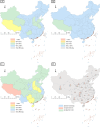Association between maternal health service utilization and under-five mortality rate in China and its provinces, 1990-2017
- PMID: 38671364
- PMCID: PMC11055253
- DOI: 10.1186/s12884-024-06437-8
Association between maternal health service utilization and under-five mortality rate in China and its provinces, 1990-2017
Abstract
Background: The United Nations (UN) Sustainable Development Goal - 3.2 aims to eliminate all preventable under-five mortality rate (U5MR). In China, government have made efforts to provide maternal health services and reduce U5MR. Hence, we aimed to explore maternal health service utilization in relation to U5MR in China and its provinces in 1990-2017.
Methods: We obtained data from Global Burden of Disease 2017, China Health Statistics Yearbook, China Statistical Yearbook, and Human Development Report China Special Edition. The trend of U5MR in each province of China from 1990 to 2017 was analyzed using Joinpoint Regression model. We measured the inequities in maternal health services using HEAT Plus, a health inequity measurement tool developed by the UN. The generalized estimating equation model was used to explore the association between maternal health service utilization (including prenatal screening, hospital delivery and postpartum visits) and U5MR.
Results: First, in China, the U5MR per 1000 live births decreased from 50 in 1990 to 12 in 2017 and the average annual percentage change (AAPC) was - 5.2 (p < 0.05). Secondly, China had a high maternal health service utilization in 2017, with 96.5% for prenatal visits, 99.9% for hospital delivery, and 94% for postnatal visits. Inequity in maternal health services between provinces is declining, with hospital delivery rate showing the greatest decrease (SII, 14.01 to 1.87, 2010 to 2017). Third, an increase in the rate of hospital delivery rate can significantly reduce U5MR (OR 0.991, 95%CI 0.987 to 0.995). Postpartum visits rate with a one-year lag can reduce U5MR (OR 0.993, 95%CI 0.987 to 0.999). However, prenatal screening rate did not have a significant effect on U5MR.
Conclusion: The decline in U5MR in China was associated with hospital delivery and postpartum visits. The design and implementation of maternal health services may provide references to other low-income and middle-income countries.
Keywords: China; Maternal health service; Under-five mortality rate.
© 2024. The Author(s).
Conflict of interest statement
The authors declare no competing interests.
Figures


Similar articles
-
Trends, influencing factors and prediction analysis of under-five and maternal mortality rates in China from 1991 to 2020.Front Public Health. 2023 Oct 19;11:1198356. doi: 10.3389/fpubh.2023.1198356. eCollection 2023. Front Public Health. 2023. PMID: 37927855 Free PMC article.
-
Trends in under-five mortality rate in China, 1996-2020: a Joinpoint regression and correlation analysis.BMJ Open. 2024 Sep 24;14(9):e077461. doi: 10.1136/bmjopen-2023-077461. BMJ Open. 2024. PMID: 39317511 Free PMC article.
-
The association between china's primary health care reform and inequalities in primary care utilisation and maternal mortality: a quasi-experimental longitudinal study from 2010 to 2019.Int J Equity Health. 2025 Jun 13;24(1):174. doi: 10.1186/s12939-025-02541-z. Int J Equity Health. 2025. PMID: 40514647 Free PMC article.
-
Child mortality estimation: accelerated progress in reducing global child mortality, 1990-2010.PLoS Med. 2012;9(8):e1001303. doi: 10.1371/journal.pmed.1001303. Epub 2012 Aug 28. PLoS Med. 2012. PMID: 22952441 Free PMC article. Review.
-
Impact of family planning programs in reducing high-risk births due to younger and older maternal age, short birth intervals, and high parity.Semin Perinatol. 2015 Aug;39(5):338-44. doi: 10.1053/j.semperi.2015.06.006. Epub 2015 Jul 10. Semin Perinatol. 2015. PMID: 26169538 Review.
References
-
- Collaborators GS. Measuring progress from 1990 to 2017 and projecting attainment to 2030 of the health-related Sustainable Development Goals for 195 countries and territories: a systematic analysis for the global burden of Disease Study 2017. Lancet. 2018;392(10159):2091–138. doi: 10.1016/S0140-6736(18)32281-5. - DOI - PMC - PubMed
-
- Collaborators GU-M. Global, regional, and national progress towards sustainable development goal 3.2 for neonatal and child health: all-cause and cause-specific mortality findings from the global burden of Disease Study 2019. Lancet. 2021;398(10303):870–905. doi: 10.1016/S0140-6736(21)01207-1. - DOI - PMC - PubMed
-
- You D, Hug L, Ejdemyr S, Idele P, Hogan D, Mathers C, Gerland P, New JR, Alkema L. Global, regional, and national levels and trends in under-5 mortality between 1990 and 2015, with scenario-based projections to 2030: a systematic analysis by the UN Inter-agency Group for Child Mortality Estimation. Lancet. 2015;386(10010):2275–86. doi: 10.1016/S0140-6736(15)00120-8. - DOI - PubMed
MeSH terms
Grants and funding
LinkOut - more resources
Full Text Sources

